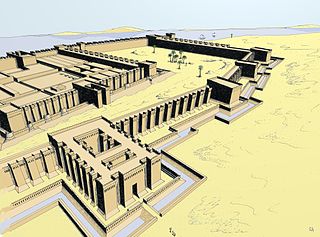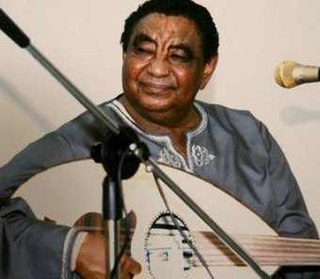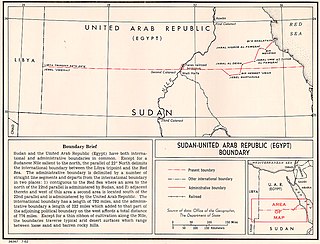Nubians are a Nilo-Saharan ethnic group indigenous to the region which is now Northern Sudan and Southern Egypt. They originate from the early inhabitants of the central Nile valley, believed to be one of the earliest cradles of civilization. In the southern valley of Egypt, Nubians differ culturally and ethnically from Egyptians, although they intermarried with members of other ethnic groups, especially Arabs. They speak Nubian languages as a mother tongue, part of the Northern Eastern Sudanic languages, and Arabic as a second language.

Muhammad Ahmad bin Abdullah bin Fahal was a Sudanese religious and political leader. In 1881, he claimed to be the Mahdi, and led a successful war against Egyptian rule in Sudan which culminated in a remarkable victory over them in the Siege of Khartoum. He created a vast Islamic state extending from the Red Sea to Central Africa, and founded a movement that remained influential in Sudan a century later.

László Ede Almásy de Zsadány et Törökszentmiklós was a Hungarian aristocrat, motorist, desert explorer, aviator, Scout-leader, and sportsman who served as the basis for the protagonist in both Michael Ondaatje's novel The English Patient (1992) and the movie adaptation of the same name (1996).

Wādī Ḥalfā is a city in the Northern state of Sudan on the shores of Lake Nubia near the border with Egypt. It is the terminus of a rail line from Khartoum and the point where goods are transferred from rail to ferries going down the lake. As of 2007, the city had a population of 15,725. The city is located amidst numerous ancient Nubian antiquities and was the focus of much archaeological work by teams seeking to save artifacts from the flooding caused by the completion of the Aswan Dam.

Lower Nubia is the northernmost part of Nubia, roughly contiguous with the modern Lake Nasser, which submerged the historical region in the 1960s with the construction of the Aswan High Dam. Many ancient Lower Nubian monuments, and all its modern population, were relocated as part of the International Campaign to Save the Monuments of Nubia; Qasr Ibrim is the only major archaeological site which was neither relocated nor submerged. The intensive archaeological work conducted prior to the flooding means that the history of the area is much better known than that of Upper Nubia. According to David Wengrow, the A-Group Nubian polity of the late 4th millenninum BCE is poorly understood since most of the archaeological remains are submerged underneath Lake Nasser.
Nobiin, also known as Halfawi, Mahas, is a Northern Nubian language of the Nilo-Saharan language family. "Nobiin" is the genitive form of Nòòbíí ("Nubian") and literally means "(language) of the Nubians". Another term used is Noban tamen, meaning "the Nubian language".

Buhen was an ancient Egyptian settlement situated on the West bank of the Nile below the Second Cataract in what is now Northern State, Sudan. Buhen, as a settlement was established during the Old Kingdom, but the fortress which Buhen is famous for was not established until the Middle Kingdom. During the Old Kingdom, Buhen was primarily used to smelt copper, until the Middle Kingdom, when the site was used by Egyptians to maintain the new southern border of Egypt.

Mohammed Osman Hassan Salih Wardi, also known as Mohammed Wardi, was a Nubian Sudanese singer, poet and songwriter. Looking back at his life and artistic career, Sudanese writer and critic Lemya Shammat called him an "inspirational figure in Sudanese music and culture, whose prolific talent and massive contribution remains unsurpassed in Sudan."
Nubia is the term commonly used by scholars to refer to the land located south of Ancient Egypt, from the city of Elephantine down to modern-day Khartoum. Nubia has been one of the earliest humanly inhabited lands in the world. Its history is tied to that of Egypt, from which it became independent in the 10th century BC. The rich gold deposits in Nubia made the latter the target of Ancient Egyptians, Greeks, Romans and later Arabs. Research on Nubia has allowed scholars to find several of its references.
Hansjoachim von der Esch was a German explorer in Egypt and Sudan, as well as German ambassador to Syria and Morocco.

Nubia is a region along the Nile river encompassing the area between the first cataract of the Nile and the confluence of the Blue and White Niles, or more strictly, Al Dabbah. It was the seat of one of the earliest civilizations of ancient Africa, the Kerma culture, which lasted from around 2500 BC until its conquest by the New Kingdom of Egypt under Pharaoh Thutmose I around 1500 BC, whose heirs ruled most of Nubia for the next 400 years. Nubia was home to several empires, most prominently the Kingdom of Kush, which conquered Egypt in the eighth century BC during the reign of Piye and ruled the country as its 25th Dynasty.
Kulb is a village on the Nile in northern Sudan. It has been inhabited since the time of the Christian kingdom of Makuria. Until the 15th century, it was in a remote area, serving as a retreat for Christians in Nubia. The domed Kulubnarti church, 21-S-1, is the only known example of a Christian center plan building in Lower Nubia.

Meinarti was an island with a Nubian village in northern Sudan. Situated in the Nile, Meinarti was just north of the 2nd Cataract, a few kilometers upstream of the Sudanese border town of Wadi Halfa. On the island was an artificial mount 175m long and 12.5m high, consisting of stratified archaeological remains. When excavated it proved to contain 18 recognizable levels, the result of six separate and distinct phases of occupation. Each phase was followed by a period of abandonment and then a complete rebuilding. Structural remains at all phases were entirely of mud brick. Meinarti was excavated by William Yewdale Adams from 1962 to 1964, prior to perishing in the 1960s with the rising of Lake Nubia due to the Aswan Dam.

The Sudans is a region in Northeast Africa comprising the sovereign countries of Sudan and South Sudan. Until 2011, the region was united under a state known as the Republic of the Sudan.
Debeira is an archaeological site in Sudan situated on the eastern bank of the Nile some 20 kilometres north of Wadi Halfa.
Suad Ibrahim Ahmed was a leader and central committee member of the Sudanese Communist Party. She was an activist for women's issues. She was a leader in the struggle against displacement of Nubian people of the Wadi Halfa region caused by erection of the Aswan Dam.

The Egypt–Sudan border is 1,276 km in length and runs from the tripoint with Libya in the west to the Red Sea in the east. The eastern section of the border is subject to a territorial dispute between the two states.

Al Balabil were a popular Sudanese vocal group of three sisters, mainly active from 1971 until 1988. Their popular songs and appearance as modern female performers on stage, as well as on Sudanese radio and television, earned them fame all over East Africa and beyond, and they were sometimes referred to as the "Sudanese Supremes". After both retiring from the stage and emigrating to the United States in 1988, they gave a revival concert in 2007 in New York City's Central Park, and later in Detroit and Chicago, as well as in their native Sudan.

The International Campaign to Save the Monuments of Nubia was the relocation of 22 monuments in Lower Nubia, in Southern Egypt and northern Sudan, between 1960 and 1980. The success of the project, in particular the creation of a coalition of 50 countries behind the project, led to the creation of the World Heritage Convention in 1972, and thus the system of World Heritage Sites.











